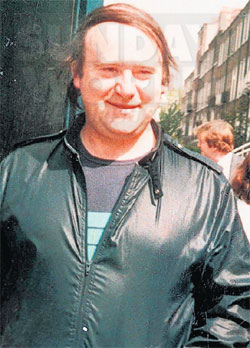Martin Cahill (Martin Cahill)

At age 16, Martin Cahill was convicted of two burglaries and sentenced to an industrial school run by the Oblates of Mary Immaculate at Daingean, County Offaly. After his release, he met and married Frances Lawless, a girl from Rathmines, where his family was now living. With his brothers, he continued to commit multiple burglaries in the affluent neighbourhoods nearby, at one point even robbing the Garda Síochána depot for confiscated firearms. The Cahill brothers soon turned to armed robbery, and by the early 1970s Gardaí at the Dublin Central Detective Unit (CDU) had identified the Cahill brothers as major criminals, when they teamed up with the notorious Dunne gang in Crumlin to rob security vans conveying cash from banks. In 1978, Dublin Corporation began preparing to demolish Hollyfield Buildings. Cahill, then serving a four-year suspended prison sentence, fought through the courts to prevent his neighbourhood’s destruction. Even after the tenements were demolished, he continued to live in a pitched tent on the site. Finally, Ben Briscoe, the Lord Mayor of Dublin, paid a visit to his tent and persuaded him to move into a new house in a more upscale district of Rathmines. Martin Cahill and his gang famously stole gold and diamonds with a value of over IR£2 million (€2.55 million) from O’Connor’s jewellers in Harolds Cross (1983); the jewellers subsequently was forced to close, with the loss of more than one hundred jobs. He was also involved in stealing some of the world’s most valuable paintings from Russborough House (1986) and extorting restaurants and hot dog vendors in Dublin’s nightclub district.
Fearing the increasing role that forensic science could play in detecting his robberies, in May 1982 Martin Cahill had a bomb placed under the car of chief forensic scientist, Dr James O’Donovan, partly disabling him. In February 1988, a Today Tonight report identified Cahill as the man behind the O’Donovan bomb plot, the Beit robbery and the robbery of O’Connors jewellery depot. As a result, PD leader Dessie O’Malley raised in the Dáil the revelations that Cahill owned such expensive property in Cowper Downs, despite having never worked, remarking that Cahill must have needed the extra wall space to “hang his artwork by the Dutch masters.” As a result, the Gardaí set up a Special Surveillance Unit (SSU), nicknamed “Tango Squad”, to specifically target and monitor Cahill’s gang on a permanent, 24/7 basis. Cahill was given the callsign Tango-1. The SSU also placed a direct presence on the estate at Cowper Downs, positioning a surveillance unit in the home of developer John Sisk, whose house backed onto Cahill’s. Following the arrest of two of Cahill’s associates in an attempted robbery, and resentful of the large Garda presence near his home, Cahill retaliated by ordering his men to slash the tyres of 197 cars on the night of 26 February 1988 (including 90 belonging to his neighbours in Cowper Downs). Cahill returned home to find his own Mercedes-Benz smashed.
In early 1993, John “The Coach” Traynor met his boss Martin Cahill to provide him with inside information about the inner workings of the National Irish Bank (NIB) head office and branch at College Green, Dublin. Traynor told Cahill that the bank regularly held more than €10 million in cash in the building. The plan was to abduct NIB CEO Jim Lacey, his wife and four children and take them to an isolated hiding place. There, they would be held with fellow gang member Jo Jo Kavanagh, acting as a “hostage”, who would frighten Lacey into handing over every penny stored in the bank’s vaults. On 1 November 1993, Cahill’s gang seized Lacey and his wife outside his home in Blackrock. Whilst they were held at Lacey’s home, Kavanagh was brought in and tied up, telling the family that he had been abducted two weeks before. On 2 November, Kavanagh drove Lacey to College Green to collect the ransom money, with Lacey eventually withdrawing IR£300,000 from an accessible cash machine. Kavanagh then drove the pair and the money to the local Gardaí station, where he told them the pair had been kidnapped and forced to take part in a robbery. With a ransom note requesting payment of €10 million in cash, the Gardaí began investigating. They quickly found that Kavanagh had claimed child allowance during his two-week “capture”, and so arrested him. Cahill then planned with Kavanagh to “raid” Kavanagh’s home, and show intent to kill the Lacey family by shooting Kavanagh in the leg. Kavanagh was then to call the Irish newspapers from his hospital bed, and claim he was a victim of the Lacey kidnapping gang. However, the plan failed, and the gang were arrested.
With all gang members from the Lacey kidnapping released on bail, on 18 August 1994, Martin Cahill left the house at which he had been staying at Swan Grove and began driving to a local video store to return a borrowed copy of Delta Force 3: The Killing Game. Upon reaching a road junction (where Oxford Road meets Charleston Road) he was repeatedly shot in the face and upper torso and died almost instantly. The gunman, who was armed with a .357 Magnum revolver, jumped on a motorbike and disappeared from the scene.
Born
- May, 23, 1949
- Dublin, Ireland
Died
- August, 08, 1994
- Dublin, Ireland
Cause of Death
- gunshot wounds
Cemetery
- Mount Jerome Cemetery and Crematorium
- Dublin, Ireland

